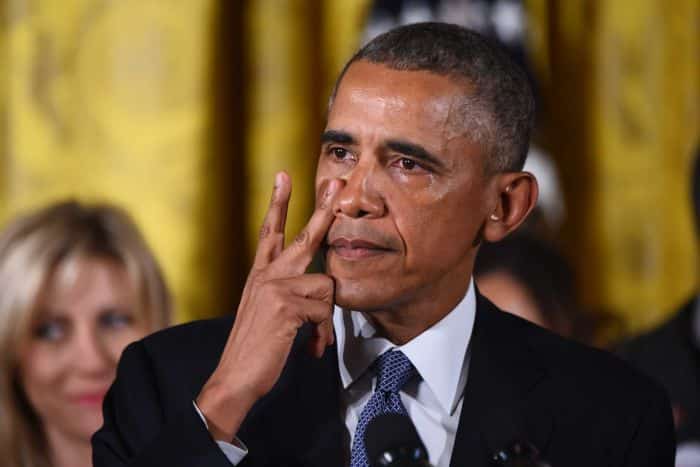After every mass shooting, there’s a new ritual: sharing an old Twitter post from a British columnist that says: “In retrospect Sandy Hook marked the end of the US gun control debate. Once America decided killing children was bearable, it was over.”
But “America” decided no such thing after the December 2012 elementary school massacre in Newtown, Conn. Poll after poll in early 2013 showed a near-unanimous consensus of Americans supporting legislation to close all loopholes in the background check system, and smaller majorities backing bans on assault weapons and high-capacity magazines. A bipartisan background check bill, drafted by Joe Manchin and Pat Toomey, won the support of a Senate majority. It was defeated, four months after the tragedy, by a filibustering Senate minority.
America’s gun control majority hasn’t decided that the murder of children is a “bearable” cost for preserving our constitutional freedoms. It simply hasn’t figured out how to overcome the intense opposition from the gun rights minority, in a system of government designed to give disproportionate power to lightly populated rural areas, where love of gun rights runs deep, and intense minority opposition, a category that includes gun owners. Figuring it out is crucial for gun control advocates, and it requires a better understanding of why the gun control push failed after Sandy Hook.
One easy culprit is the Senate’s filibuster rule. A background-check bill like Manchin-Toomey would likely pass without a filibuster—even red state Democrats like Manchin and Sen. Doug Jones of Alabama support universal background checks. But everyone knows that a background check bill isn’t a panacea; several of the most recent mass shooters were young men without criminal records who legally obtained their weapons.
More ambitious gun legislation remains a harder sell. Democrats put an assault weapons ban on the Senate floor in 2013, and it received only 40 votes, with several swing state Democrats who are still in the Senate—Colorado’s Michael Bennet, New Mexico’s Martin Heinrich, Maine’s Angus King (a nominal independent), Montana’s Jon Tester and Virginia’s Mark Warner—voting against it.
The main problem gun control advocates had in 2013 was not the rules but the lack of a mandate, the product of Democratic squeamishness about gun control going back several years.
Many Democrats had been uncomfortable with gun control since the moment President Bill Clinton enacted the assault weapons ban in 1994, over the private opposition of the House Democratic leadership. When Democrats were decimated in the 1994 midterm elections, including Speaker Tom Foley, gun control was blamed. (In his autobiography, Clinton wrote that the National Rifle Association “could rightly claim to have made [Newt] Gingrich the House speaker.”)
Then the 1999 Columbine school shooting rekindled Democratic interest in gun control, and Vice President Al Gore cast a tie-breaking Senate vote to pass a measure requiring background checks for purchases at gun shows. But the Republican-led House teamed up with conservative Democrats, still scarred by the 1994 backlash, to squelch it.
The gun issue then dogged Gore’s 2000 presidential bid. Under pressure from his lone primary rival Sen. Bill Bradley, Gore endorsed a ban on cheap handguns, along with a photo-license requirement for purchasing other handguns. Gore futilely tried to downplay that stance during the general election, and some Democrats attributed his defeat to it. Shortly before Election Day 2004, Democratic presidential nominee John Kerry awkwardly tried to leaven his support for renewing the assault weapons ban, which Republicans had just let expire, by going goose hunting.
And so Barack Obama released an approving statement during the 2008 presidential campaign when the Supreme Court declared that the Second Amendment enshrines an individual right to bear arms, and proceeded to flip several states with significant gun-owning constituencies. In his first term, Obama did not push for gun control measures after the fatal mass shootings at Fort Hood, Texas; an Aurora, Colorado, movie theater; and the Tucson, Arizona supermarket that cut short Rep. Gabby Giffords’ congressional career. He continued to keep quiet on gun control in the 2012 presidential campaign as well.
The Sandy Hook massacre, which took place one month after the 2012 election, upended Obama’s second-term legislative agenda. The national trauma resulting from the murders of 20 small children was so profound that Obama reasonably concluded this was not a time for caution and calculation. In January 2013, Obama proposed a long list of measures, including bans on assault weapons and armor-piercing bullets and a limit on the size of magazines.
And yet he began his gun control push from a position of political weakness. He had not campaigned on gun control, let alone a specific set of gun control proposals. He couldn’t influence lawmakers with clear evidence of red- and purple-state voters who were dedicated to his proposals. No broad-based gun control movement was in place to apply grassroots pressure.
Meanwhile, the National Rifle Association had cultivated for decades a movement of single-issue voters, fostering a cultural identity around gun ownership that fortifies its legal and constitutional arguments. We now know that the NRA leadership was internally conflicted about how to respond to the unique horror that was Sandy Hook, but the ultimate decision to continue its unwavering defiance against any gun restrictions worked perfectly, and kept most Republicans (and a few Democrats) in line.
Today, gun control advocates are more optimistic because support in polls for their ideas is strong, the NRA has been distracted by internal strife, and President Donald Trump has hinted that he could push for a background-check bill or a red-flag bill. If Trump shocks us all by challenging the NRA and breaking its back, he will have done the Democrats’ job for them. But it remains very hard to fathom that Trump, along with Senate Majority Leader Mitch McConnell, would get behind any bill that draws the NRA’s vehement opposition. And any bill that had the NRA’s blessing would not be much of a bill.
The next serious opening for gun control legislation, then, will most likely be when Democrats get control of the White House and the Senate, however narrowly. But to be better positioned than Obama was in 2013, Democrats have to run on gun control now and run on it hard.
Some gun control advocates argue that Democrats have been running on the issue, noting that in the 2018 midterms, most of the candidates endorsed by Everytown and Giffords’ pro-gun control political action committee won, and that 15 House Republicans with “A” ratings from the NRA were replaced by Democrats with “F” ratings.
However, it’s all too easy for winning candidates to wrongly assume that nominally running on an issue means you have won the public’s commitment on it. In George W. Bush’s victory lap after his 2004 reelection, he declared, “I earned capital in the campaign, political capital, and now I intend to spend it [on] Social Security and tax reform.” And it’s true that he had campaigned in part on a plan to partially privatize Social Security. But he learned the hard way that just because he said something on occasion on the campaign trail, that didn’t mean the voters were paying close attention.
Once Bush began his second term with a concerted push for Social Security reform, Democrats mercilessly hammered the plan. Public polling for it was limp. After months of flailing and frittering away all that political capital, Bush shelved the plan.
The lesson is that Democrats have to not just run on gun control, but also make it central to the 2020 election. That means campaigning on gun control not only in the immediate aftermath of traumatic mass shootings, but on all the other days when gun violence is still happening off our TV screens.
Most of the approximately 36,000 annual gun deaths are not from mass shootings and not from assault-style weapons. About 22,000, slightly less than two-thirds, are suicides. Others result from domestic violence, routine crimes and accidents. Of the homicides, nearly two-thirds are from handguns, not military-style assault rifles. These quieter deaths, unlike domestic terror incidents with high body counts and flamboyant weaponry, happen every day. They must be talked about every day if a movement fueled by a strong sense of urgency is to be built. Presidential candidates could begin every stump speech with a recounting of the gun deaths that happened in the past week, to drive home the point that every day without action is a day when someone needlessly dies.
Such a strategy is not without significant political risk. There is a reason why Obama did not try to build a robust gun control mandate in 2008 and 2012: He probably would have lost critical swing states like Ohio, Iowa and Colorado.
By BILL SCHER, Politico Magazine, Read full article
PHOTO: Mr Obama has often said his toughest time in office was grappling with the Newton massacre in December 2012. (AFP: Jim Watson)
Redazione
La redazione di Babilon è composta da giovani giornalisti, analisti e ricercatori attenti alle dinamiche mondiali. Il nostro obiettivo è rendere più comprensibile la geopolitica a tutti i tipi di lettori.
Dall’origine straniera all’icona americana: il fenomeno dello sport negli Usa
14 Mar 2024
Molti sport americani sono accomunati da un aspetto particolarmente curioso: raramente sono davvero nati sul suolo…
Roulette europea, francese o americana? Ecco un approfondimento
22 Set 2023
La roulette è un classico intramontabile dei casinò, amata da milioni di appassionati in tutto il mondo. Una delle…
Conto corrente online: perché è la soluzione migliore per i più giovani
21 Ott 2022
I millennial e i nativi digitali hanno dimostrato di essere una forza in grado di cambiare le carte in tavola nel…
L’intrattenimento online è dei casinò
31 Ago 2022
Il mondo dell’intrattenimento è vasto e ricco di opzioni. Con l’avvento di internet, poi, il settore non fatto altro…




